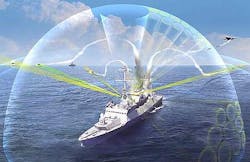Lockheed Martin, L-3 combine forces on optical warfare system to defend Navy surface warships
The contract calls for electro-optical surface ship defense experts at Lockheed Martin to enhance surface warship multi-band defenses against concentrated enemy attacks involving different optically guided weapons like anti-ship missiles, fast attack boats, and unmanned aerial vehicles (UAVs).
Officials of the Naval Research Laboratory in Washington announced a $10.6 million contract Wednesday to the Lockheed Martin Laser and Sensor Systems segment in Bothell, Wash., (formerly Aculight) to develop the Multispectral EO/IR Countermeasures for Advanced Threats (MEIRCAT) function of the Combined EO/IR Surveillance and Response System (CESARS) program.
CESARS combines two optical warfare research initiatives -- MEIRCAT, and the Shipboard Panoramic EO/IR Cueing and Surveillance System (SPECSS). L-3 Cincinnati Electronics in Mason, Ohio, won a $9 million Navy contract earlier this month to develop the SPECSS portion of the CESARS program.
Related: Will human sight be the worst casualty of future optical warfare?
Lockheed Martin's MEIRCAT subsystem will perform target re-acquisition, tracking, classification, identification, 3-D ranging, threat assessment, countermeasures execution, and countermeasures effectiveness monitoring (CMEM). It will offer multi-band capability against many different targets in one engagement.
The SPECSS subsystem from L-3 Cincinnati Electronics will include an enhanced electro-optical and infrared (EO/IR) countermeasure and situational awareness capability to perform wide field-of-view target detection and tracking, and cueing of MEIRCAT high-resolution sensors.
Together these two technology capabilities are intended to provide a comprehensive shipboard defense against optically guided anti-ship missiles, attack boats, and attack drones.
Optical warfare is part of an evolving military discipline called spectrum warfare, which combines optical warfare, electronic warfare (EW), and cyber warfare under one umbrella for military conflicts of the future.
On the combined CESARS program, Lockheed Martin and L-3 Cincinnati Electronics will use modular, open-systems hardware and software architectures that are scalable to different platforms. MEIRCAT and SPECSS interfaces, data formats, and source code, will be non-proprietary and government owned.
The overall CESARS system design approach will capitalize on common imaging components and technologies in a flexible design expected to reduce maintenance and repair costs, as well as to provide a simple and effective approach to upgrade the system as newer technologies become available, Navy researchers say.
The CESARS program calls for Lockheed Martin and L-3 Cincinnati Electronics to develop the SPECSS and MEIRCAT systems independently. The Navy will handle integrating the two for shipboard integration. Non-proprietary hardware and data interchange standards will help exchange data among the two systems.
The overall CESARS system from Lockheed Martin, Cincinnati Electronics, and the Navy also will provide video data acquisition, dissemination, recording, processing, and display; high-resolution classification, identification, and tracking in several optical wavebands; integrated, precise, and real-time, active and passive fine tracking and ranging in several wavebands; enhanced countermeasures capability; and provide precise 3-D ranging and countermeasures monitoring to the shipboard combat system.
Related: Air Force launches spectrum warfare program covering EW, optical, GPS, and cyber warfare
The CESARS program will consist of five separate products. Lockheed Martin engineers will develop MEIRCAT high-resolution cameras; laser sources; and MEIRCAT hardware, software, integration, and testing. L-3 Cincinnati Electronics, meanwhile, will develop the SPECSS camera and SPECSS signal processing.
On the contract announced Wednesday, Lockheed Martin will do the MEIRCAT work in Bothell, Wash., and should be finished by March 2020. L-3 Cincinnati Electronics is doing the SPECSS work in Mason, Ohio, and should be finished by November 2018.
For more information contact Lockheed Martin Laser and Sensor Systems online at www.lockheedmartin.com/us/products/laser-sensor-systems, L-3 Cincinnati Electronics at www2.l-3com.com/ce, or the Naval Research Laboratory at www.nrl.navy.mil.
